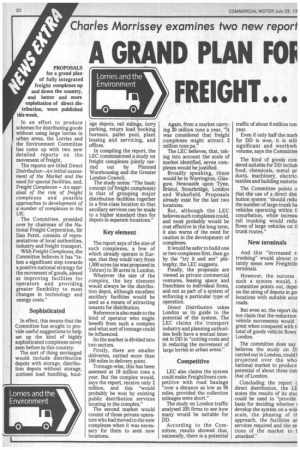Charles Morrissey examines two new repori
Page 22

If you've noticed an error in this article please click here to report it so we can fix it.
A GRAND PLAN FOE FREIGHT...
PROPOSALS for a grand plan of fully integrated freight complexes up and down the country, and better and more exploitation of direct distribution, were published this week.
In an effort to produce schemes for distributing goods without using large lorries in urban areas, the Lorries and the Environment Committee has come up with two new detailed reports on the movement of freight.
The reports are titled Direct Distribution—An initial assessment of the Market and the need for special facilities, and, Freight Complexes — An appraisal of the role of freight complexes and possible approaches to development of a number of complexes in the UK.
The Committee, presided over by chairman of the National Freight Corporation, Sir Dan Pettit, consists of representatives of local authorities, industry and freight transport.
With Freight Complexes, the Committee believes it has "taken a significant step towards a positive national strategy for the movement of goods, aimed at improving facilities for operators and providing greater flexibility to meet changes in technology and energy costs."
Sophisticated
In effect, this means that the Committee has sought to provide useful suggestions to help set up the kind of highly sophisticated complexes never seen before in this country.
The sort of thing envisaged would include distribution depots with storage, distribution depots without storage, unitised load handling, haul age depots, rail sidings, lorry parking, return load booking bureaux, pallet pool, plant leasing and servicing, and offices.
In compiling the report, the LEC commissioned a study on freight complexes jointly carried out by Planned Warehousing and the Greater London Council.
The study notes: "The basic concept (of freight complexes) is that of grouping major distribution facilities together in a first-class location so that ancillary services can be made to a higher standard than for depots in separate locations."
Key element
The report says of the size of such complexes, a few of which already operate in Europe, that they could vary from 1,000 acres (as was proposed in Tehran) to 20 acres in London.
Whatever the size of the complex, the key element would always be the distribution depot, although excellent ancillary facilities would be used as a means of attracting tenants for distribution.
Reference is also made to the kind of operator who might benefit from such a complex and what sort of tonnage could be influenced.
So the market is divided into two sectors.
Firstly, there are smaller deliveries, carried more than 100 miles to delivery point.
Tonnage-wise, this has been assessed at 19 million tons a year. But the complex would, says the report, receive only 2 million, and this "would probably be won by existing public distribution services locating in the complex."
The second market would consist of those private operators who had moved to the new complexes when it was necessary for them to seek new locations. Again, from a market carrying 20 million tons a year, "It was considered that freight complexes might attract 2 million tons pa."
The LEC believes, that, taking into account the scale of market identified, seven complexes would be justified.
Broadly speaking, these would be in Warrington, Glasgow, Newcastle upon Tyne, Bristol, Stourbridge, London and Wakefield. Proposals already exist for the last two locations.
But, although the LEC believes such complexes could, and most probably would be cost effective in the long term, it also warns of the need for caution in the development of complexes.
It would be safer to build one or two complexes first, then go by the "try it and see" philosphy, the LEC suggests.
Finally, the proposals are viewed as private commercial ventures, leasing space and franchises to individual firms, and not as part of a system of enforcing a particular type of operation.
Direct Distribution takes London as its guide to the potential of the system. The LEC claims the transport industry and planning authorities both have a mutual interest in DD in "cutting costs and in reducing the movement of large lorries in urban areas."
Competitive
LEC also claims the system could make Freightliners competitive with road haulage "over a distance as low as 95 miles, provided the collection mileages were short."
The study on London traffic analysed 255 firms to see how many would be suitable for DD.
According to the Committee, results showed that, nationally, there is a potential traffic of about 6 million ton: year.
Even if only half the marli for DD is won, it is still significant and worthwh volume, says the Committe€ The kind of goods corm dered suitable for DD includ food, chemicals, metal pr ducts, machinery, electric textiles and building materia The Committee points o that the use of a direct dist bution system "should redu the number of large trunk ha vehicles operating within ti conurbation, while increasi rail trunking would redu flows of large vehicles on ti trunk routes."
New terminals
And this "increased n trunking" would almost c( tainly mean new Freightlin terminals.
However, the success such a system would, t committee points out, depei on the siting of depots in gol locations with suitable acce roads.
But even so, the report do not claim that the reduction vehicle movements would 1 great when compared with t] total of goods vehicle flows London.
The committee does say believes the study on DJ carried out in London, could I projected over the who national market to produce potential of about three timt that of London.
Concluding the report c direct distribution, the LE states the results of its stuc could be used to "provide basis for deciding whether a develop the system on a wich scale, the phasing of a approach, the facilities ar services required and the se tions of the market to t attacked."




















































































